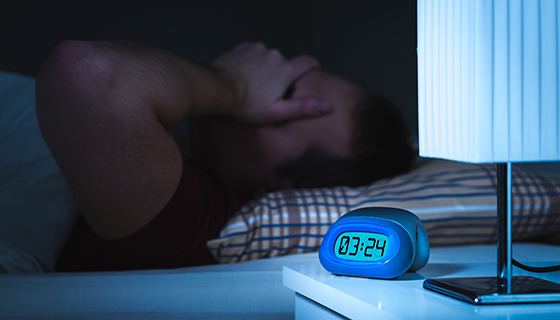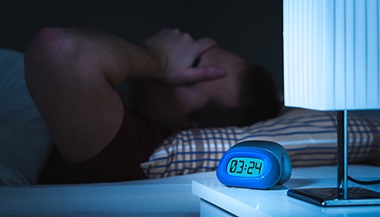Primary Sleep Disorders: Parasomnia
Parasomnia disorders involve some type of abnormal behavior during sleep, such as walking or talking. Parasomnias may be categorized as primary parasomnias (disorders of sleep states) or secondary parasomnias (disorders of other organ systems that may manifest during sleep, including seizures, respiratory dyskinesia and gastroesophageal reflux).
Symptoms
Sudden partial awakening associated with confusion and disorientation
Sleepwalking, or arousal with complex motor behaviors like walking, running, talking or eating
Paralysis occurring near the onset or end of sleep or during awakenings
Repetitive grinding of the teeth during sleep
These are the 4 most common parasomnias:
Nightmares and nightmare disorder
Night terrors
Sleepwalking
Nightmares and nightmare disorder
Nightmares are frightening dreams that jolt the sleeper awake suddenly. People usually remember vivid details about their nightmares. If you have the same nightmare over and over, you're experiencing a nightmare disorder.
In adults, nightmares are frequently connected with conditions such as post-traumatic stress disorder, depression, and schizophrenia. They can happen more often during stressful life situations, such as the death of a loved one, a breakup or divorce, or loss of a job. They can also be related to certain medicines, such as antidepressants, narcotics, or seizure medicines.
Night terrors
Night terrors, also known as sleep terrors, are episodes of fear, confusion, and screaming during sleep. Toddlers experiencing night terrors may try crawling or walking in their sleep; if this happens, they have to be watched so that they don't hurt themselves. Night terrors usually last a few seconds to a few minutes and often occur with sleepwalking. Unlike with nightmares, a person experiencing a night terror will not wake up and will not remember anything the next morning.
Nightmares and night terrors are more common in children than adults. In children, they are rarely caused by a physical or mental illness. Both nightmares and night terrors are more common in people with other sleep problems, such as obstructive sleep apnea.
If your child is having nightmares, he or she will usually wake up suddenly and may come to you for comfort. You can explain to your child that he or she has had a bad dream.
Children experiencing a night terror might have their eyes open and seem to be awake, yet be confused, glassy-eyed, and unable to communicate. The child is often inconsolable. Your child might also:
Sit up in bed
Scream or shout
Kick or thrash around frantically
Breathe heavily and sweat
Be hard to wake up or hard to calm down
Stare wide-eyed
Get out of bed and crawl or run around the house
If your child is having a night terror, talk to your child calmly and gently and try to get him or her back into bed without shouting or shaking the child.
Diagnosis
Nightmares and night terrors are usually diagnosed by history alone. Some adults might need to undergo more evaluation, such as nerve testing, to make sure they do not have an underlying problem related to the night terrors.
Treatment
Nightmares and night terrors can be frightening, but they are usually nothing to worry about. Most children will outgrow them by the time they are teenagers. But it's important to make sure your child or family member is safe from harm during the night.
If your child has night terrors, you may need to place gates on staircases to prevent injury and remove dangerous objects from your home. Children who have frequent night terrors should not sleep in bunk beds. Be sure to talk with your doctor if you or a family member ever gets hurt while sleeping.
Adults who have frequent nightmares and night terrors may benefit from cognitive behavioral therapy (CBT). CBT can be done with a counselor or at a sleep medicine center and can be effective after only a few sessions.
Bedwetting
Doctors refer to nighttime bedwetting as nocturnal enuresis. This condition is fairly common in children. It's not unusual for children younger than 6 to wet the bed. It tends to affect boys more than girls. Enuresis is also much more common in children whose parents both had enuresis as children.
Bedwetting often occurs when a child makes too much urine for the amount that his or her bladder can store. Children with the condition don't wake up when their bladder is full.
Diagnosis
You should take your child to the doctor if he is still wetting the bed after age 6. The doctor will probably ask you about your child's bathroom habits during the day and night and do a physical exam. The doctor will also do a urine test called a urinalysis to see if there is an obvious cause for the bedwetting, like a urinary tract infection or diabetes.
The doctor might ask you about how things are going at school and at home for your child. Although your child's bedwetting might be concerning to you, children who wet the bed are usually not more emotionally upset than other children.
If the doctor finds no underlying cause, the bedwetting is called primary nocturnal enuresis. If a separate medical condition, such as a urinary tract infection, diabetes, spinal cord abnormalities, or malformations of body parts like the urethra, is causing the bedwetting, it's called secondary nocturnal enuresis.
Treatment
Most children do not need treatment for bedwetting. If your doctor decides to treat your child, it will probably be with behavioral therapy or medication. These are possible behavioral therapy treatments:
Limit fluids before bedtime.
Have your child go to the bathroom at the beginning of the bedtime routine and again right before getting into bed.
Reward your child for dry nights.
Have your child help you change the sheets when he or she wets the bed.
Give your child bladder training, which involves having your child practice holding his or her urine for a while throughout the day so that the bladder stretches to accommodate more urine.
If behavioral therapy doesn't work for your child, and he or she is at least 7 years old, your doctor might prescribe medicine. One type of medicine helps the bladder hold more urine, and the other causes the kidneys to make less urine. These medicines can have side effects like flushing of the cheeks and dry mouth, and they are not a cure for bedwetting.
Helping your child cope
It is important to remember that bedwetting is not a child's fault. It is not a mental or behavioral problem, and it does not happen because a child is too lazy to get out of bed. You should not make your child feel guilty or ashamed, or punish him or her for wetting the bed.
Encourage your child to use the bathroom during the night, and place nightlights in hallways and rooms to make this easier. It may be helpful to use a waterproof mattress pad.
Sleepwalking
Sleepwalking, also know as somnambulism, is a disorder in which a person partially wakes up during the night and walks around without realizing it. The sleepwalker might make repetitive movements, such as fumbling with clothing, get out of bed and stroll around, or even talk to you. Sleepwalking is usually not a cause for concern. Most children will outgrow sleepwalking by their teenage years.
If your child is sleepwalking, try to guide him or her gently back to bed. Don't shake or yell at your child in an attempt to wake him or her up. Another important consideration is your child's safety. As with night terrors, remove dangerous objects from the home and place gates on stairs to prevent falls. Keep doors and windows locked.
Most children will not need treatment for sleepwalking. If your child sleepwalks for a long time or is having problems during the day due to lack of sleep, talk with your doctor. You might want to keep a sleep diary for a few weeks and record when your child sleepwalks. One method sometimes used to treat sleepwalking is waking your child up 15 minutes before he or she normally sleepwalks, but talk with your doctor before doing so.






